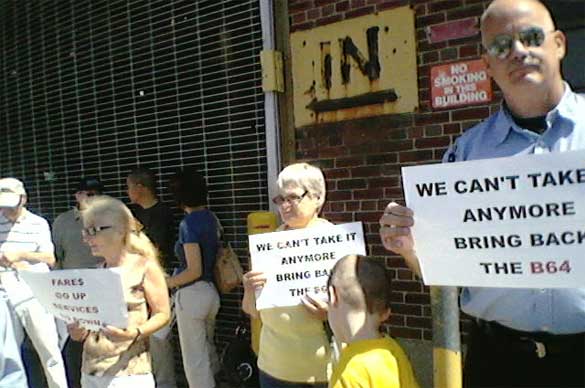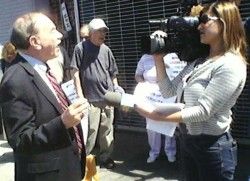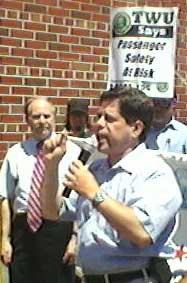Around 120 Protesters Demand B64 Restoration In Bath Beach

THE COMMUTE: Last week, I had to conduct some business at the courts in Downtown Brooklyn. The trip going there using a bus and train, and two trains and a bus to return home, including the two minutes I spent at the court, took me less than 90 minutes. That was fabulous, but mass transit is often not that quick in New York City, especially when the bus you used to rely on no longer operates and you need to find alternatives.
Today, bus riders are still reeling from the effects of 36 bus routes eliminated in June 2010. Last month, Sheepshead Bites held a Transit Town Hall, primarily to ask for restoration of the B4 cut. Last Saturday was Bensonhurst’s turn.

Demonstrators gathered at Ulmer Park Depot, 25th Avenue near Cropsey Avenue, at 11:00 a.m. to protest the cutback of the B64 bus from Coney Island to 25th Avenue. The western terminus of the route is in Bay Ridge. The community last protested this service cut shortly after it occurred back in June 2010. Hopefully, this protest will be more successful. It had the support of Local 100 of the TWU, which promised to support restoration of all the 2010 service cuts. Approximately 50 of the demonstrators were Local 100 members. I previously wrote about the B64 just under a year ago and again when discussing the MTA’s evaluation of these service cuts last October.
The Bensonhurst West End Community Council (BWECC) and Assemblyman William Colton organized both protests. Colton spoke about churches that were inconvenienced and asked why the MTA would cut a route providing service to Coney Island at the same time the city is spending millions to rejuvenate the area. He stated that made no sense. Approximately a dozen people spoke on behalf of restoring the B64, including TWU President John Samuelson. Other elected officials speaking were Councilman Vincent Gentile, Assemblyman Alec Brook-Krasny representing Coney Island, and Anthony Testeverde, a regular B4 rider in Sheepshead Bay, representing State Senator Martin Golden.

Among those who spoke from the public were representatives from local schools, and seniors and the disabled, who were inconvenienced most by the B64 cutback. What is most annoying to the residents is that, although the B64 no longer operates along Harway Avenue, buses still use the street all day long as a run on and run off route to access the B36. They do not understand why these same buses could not be scheduled to operate as B64s and how operating buses not in service saves the MTA money. Many believe the MTA is not saving what they thought they would be saving by truncating the route since they did not factor in patronage losses in their cost saving projections. The assumption made was that all riders would find a mass transit alternative.
That clearly was not the case since, one year after the cut, the MTA’s own analysis showed the B64 to be 41 percent less efficient on weekdays and 38 percent less efficient on weekends due to fewer riders using the route. When I pointed this out to a senior MTA service planner last year, he told me the only thing that mattered was that they saved money, implying it could not be helped if the routes became less efficient.
Assemblyman Jim Brennan is introducing legislation that would hold the MTA accountable for their cost savings projections, which are often over-projected when making service changes by only considering operational savings ignoring other factors such as efficiency.
Todd Dobrin, who also has political aspirations, wanted to know why the MTA didn’t do a study to determine how much more they are paying for Access-A-Ride trips since the cutbacks. Those trips cost the MTA an average of about $60 per trip, far more than the cost of service for a local bus, which costs around $3 or $4 per trip to provide.
The elderly and handicapped, who often cannot climb the subway stairs, must now rely on Access-A-Ride for trips they previously made by bus. One rider confined to a wheelchair stated that seniors are now prisoners in their own homes because they can no longer access the senior center on Bay 47th Street and Harway Avenue, previously serviced by the B64.
A leader of the Asian community stated that the Asian population increased by 53 percent in Bensonhurst and the overall population of the area increased by eight percent, and questioned why the MTA was reducing bus service. The answer to that question is that the MTA only considers its own current riders when planning — not potential ridership in an area with population growth or an area undergoing revitalization such as Coney Island. Increased ridership resulting from bus service improvements are not considered either. The MTA assumes no one will ride a new service when figuring the cost to provide it. The “if you build it they will come” philosophy is a foreign concept to the MTA, who is only concerned with penny-pinching and cost savings, not efficiency or improving bus service.
Other Observations
Although B64 buses are supposed to turn around in front of the depot, while waiting I noticed several buses going beyond 25th Avenue, probably to 26th Avenue to make their turn. Even if the MTA merely formalized that turn around and allowed the buses to pick up and drop off riders on 26th Avenue, or if they just operated school specials to service the schools inconvenienced by the B64 service cut, it would help somewhat. However, the MTA’s planners and budget people have lost sight of their mission to service the people in the best manner possible within available resources. They only restore a service when the political outcry becomes too great.
Problems With The B3
I decided to take the bus to the Ulmer Park Depot rather than drive. Arriving at 25th Avenue and 86th Street on the B1, I wondered if I should gamble on waiting for a B3 on 25th Avenue or just walk the last three long blocks. Since I was feeling well and not having any difficulty walking that day, I decided to walk. Moments later, not one, not two, but three B3s passed me, one right after the other. Guess I gambled wrong.
Since the bus is supposedly operating on a 10-minute interval, that means some people are waiting 30 minutes or more for the bus. During the hour and a half the protest lasted, I decided to spend some time watching the B3. This is what I found: Two of the three B3s, which arrived at the last stop in front of the depot at same time, also left for their return trip — also at the same time. Furthermore, when I boarded the B3 to go home, another B3 passed us in service only one block from the beginning of the route. That’s two instances within 90 minutes where B3 buses were leaving the terminus already bunched!
So how can buses operate at their scheduled intervals if they are not even dispatched one at a time? I previously heard the same complaint regarding the B36. I asked the B3 driver to explain to me what was happening. All he would say was the other driver must be late. The MTA allows time where bus operators get a break at the end of each trip, called recovery time, so that they can get back on schedule if there are any delays along the route. If the driver who spoke to me was correct, the recovery time for the B3 is insufficient.
I noticed on many occasions that the B4 gets a 20-minute recovery time at Coney Island Hospital, which seems excessive. Why should the B3 recovery time be insufficient and the B4 recovery be excessive? These are issues the MTA needs to investigate because, as I often state, excessive wait times are the biggest deterrent to not using buses.
In my conversation with Senator Golden’s representative, Anthony Testeverde, who uses the B3 and the B4 to get from Marine Park to his office in Bay Ridge, the B3 often has delays of 30 minutes and, on those days, it takes him two hours to get to his office. When he would just miss several B3s in a row he would jog from Avenue U to Voorhies Avenue along Knapp Street to pick up the B4 directly instead of waiting 30 minutes for the B3 and transferring at 25th Avenue and 86th Street for the B4. Now he no longer has that option during the midday and on weekends since the B4 cutback, and has no choice but to wait for the B3.
Last month, I unveiled proposed bus route improvements such as bus service along Knapp Street, which the MTA will never provide as long as they are only interested in cutting bus service, not improving it. A few weeks ago, the MTA announced increases to L train subway service in Williamsburg, costing an additional $1.7 million a year, because subway crowding exceeds the service guidelines. However, on my return B1 trip, the bus carried about 65 people for most of the route between 25th Avenue and Manhattan Beach, with frequent turnover, when the service guidelines call for a seated load during the off-peak and there was no other bus in sight for my entire trip. The driver even bypassed one rider on Brighton Beach Avenue because the bus was so overcrowded.
Why are there no increases in summer bus service this year on beach routes in Brooklyn as was the practice in previous years? Apparently, when it comes to buses, the MTA will not consider changes that cost more money because of their bias against buses. The guidelines only come into play to justify service reductions and are ignored when additional service is warranted.
Conclusion
Sometimes the transit system works quite well. Other times it fails miserably. Politicians can protest all they want that the MTA should restore service. The truth is that restoring service costs money. Many of the state’s elected officials now calling for service restoration are the same ones responsible for cutting the MTA’s budget in the first place, necessitating these cuts. The State Assembly and State Senate must restore MTA funding to enable them to provide adequate service. However, the MTA must do its part also by making sure the resources they are allotted are spent in the most efficient way possible.
The MTA is clearly wasting money by dispatching buses two at a time, then being dishonest by blaming bus bunching on traffic congestion, which is beyond their control. They need to dedicate far more resources to road supervision. This wasting of money is one of the reasons state elected officials voted to reduce MTA funding in the first place, as Colton told me in 2010.
On June 27, he will be attending the MTA’s monthly board meeting to once again ask for the reinstatement of the B64 and to present the MTA with petitions. He promised me that he would speak to Assemblyman Steven Cymbrowitz today in Albany about working together so they both can fight for the restoration of the B64 as well as the B4.
The Commute is a weekly feature highlighting news and information about the city’s mass transit system and transportation infrastructure. It is written by Allan Rosen, a Manhattan Beach resident and former Director of MTA/NYC Transit Bus Planning (1981).
Disclaimer: The above is an opinion column and may not represent the thoughts or position of Sheepshead Bites. Based upon their expertise in their respective fields, our columnists are responsible for fact-checking their own work, and their submissions are edited only for length, grammar and clarity. If you would like to submit an opinion piece or become a regularly featured contributor, please e-mail nberke [at] sheepsheadbites [dot] com.




